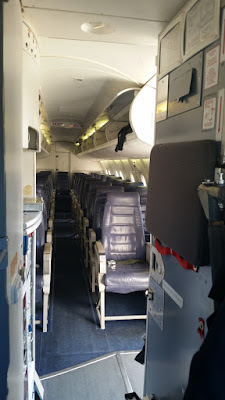Almost every airline crewmember has "slept on the job" at one time or another. However, those scare quotes are there for a reason: sleeping on the job isn't what you think of as sleeping on the job, since an airline workday is so much different from the workday that 99.9% of the rest of the world knows.
When Richard Branson (whose book Losing My Virginity: How I Survived, Had Fun, and Made a Fortune Doing Business My Way is an absolutely amazing read that I'd highly recommend to almost anyone) dropped into one of his offices last month, he came across an employee sleeping on the couch. In most jobs, this might lead to an immediate dismissal, and since most of the Internet has "normal" jobs, the electronic hills were alive with the sound of outrage.
But not Sir Richard: he laughed it off, took a smiling picture with the napper, and wrote about it on his blog. And that was entirely the correct response from the big boss.
 |
| Image from Virgin Australia. |
That's because you've never experienced the dreaded reserve shift.
When I was starting on the airline pilot path, I got to experience it for six months. Reserve is something that most jobs don't have because at most jobs, you're either producing something or you're not. You are either producing that report, cranking out that widget, making that sale, etc. or you're not. As normal bosses like to say, "You're not getting paid to just show up."
In the airline industry, we can't just create more flights. We have a pre-set schedule and slots to fill. We can't randomly tell passengers, "Just be at the airport sometime on the day you want to fly and we'll load up a plane by the end of the day. Maybe we'll have an extra flight if we feel extra motivated, so show up and maybe it will be your lucky day!"
Basically, all our widgets are already made for us, and we're there to make sure they get shipped on time. In a perfect world, where no weather ever delays an inbound flight, nothing mechanical ever breaks, and no one ever gets sick, we would have exactly as many crewmembers as we need for that day's schedule of flights.
However, since each of these annoyances occurs almost every day, airlines keep more crewmembers on hand than there are flights scheduled for them. These extras are kept in reserve just in case... hence the name "reserve" (or occasionally, "standby").
When everything goes smoothly that day, there is nothing to do while on reserve. You have no job other than to be at the airport, ready to take over a flight. That is your whole job: to be there. You can't just work harder and magically create flights that aren't on the schedule. Absolutely nothing is expected of you but to be present, in large part because there isn't anything else you could do, and being there is the only thing needed from you.
If you want to spend your time reading a book, surfing the web, walking up and down the terminal, taking courses online, watching a movie, updating the Jepp charts, or just sleeping away some otherwise dull hours—and I did each and every one of those during my time on reserve—that's all up to you. Richard Branson deserves a tip of the hat for understanding that, since so many people don't. (Then again, most people don't run their own airline, either.)
Does this seem a bit wasteful? Well, again, in a perfect world, every flight would run perfectly and no reserves would ever be needed, and there would be no waste. But in the real world, things happen, and there are two main alternatives:
1. Incur extra expense to have people at the airport on reserve so the flights still go out.
2. Have no reserves and cancel a flight anytime something goes wrong somewhere down the line.
Every airline chooses the first option, since in the end it's cheaper to have some extra people hanging around than to refund money to dozens or hundreds of people for any little hiccup. Since each crew and aircraft tend to do more than one leg a day (the airplanes especially have a longer day than the crews), if one crewmember gets sick, then it's not just one flight that would get cancelled: it affects many, many more down the line, like one domino tipping into another.
When you're at the bottom of the totem pole, you're stuck with reserve. However, like many things in life, those at the bottom have not only the hardest job but also one of the most important. Sitting around wondering if you're going to do anything, having no idea what your schedule will be that day or what city you might end up in is tough, as I pointed out when I was on reserve. However, reserves are what keep the operation running. Without them, the whole house of cards would collapse.
So this guy sleeping on a couch in the crew room? Totally fine. Sleeping in the cockpit, however, is another matter for another day.
See you sometime next week!
Like Larry the Flying Guy on Facebook:
Follow @Lairspeed
The author is an airline pilot, flight instructor, and adjunct college professor teaching aviation ground schools. He holds an ATP certificate with a DHC-8 type rating, as well as CFI, CFII, MEI, AGI, and IGI certificates, and is a Master-level participant in the FAA's WINGS program and a former FAASafety Team representative. He is on Facebook as Larry the Flying Guy, has a Larry the Flying Guy YouTube channel, and is on Twitter as @Lairspeed.
It takes hours of work to bring each Keyboard & Rudder post to you. If you've found it useful, please consider making an easy one-time or recurring donation via PayPal in any amount you choose.











